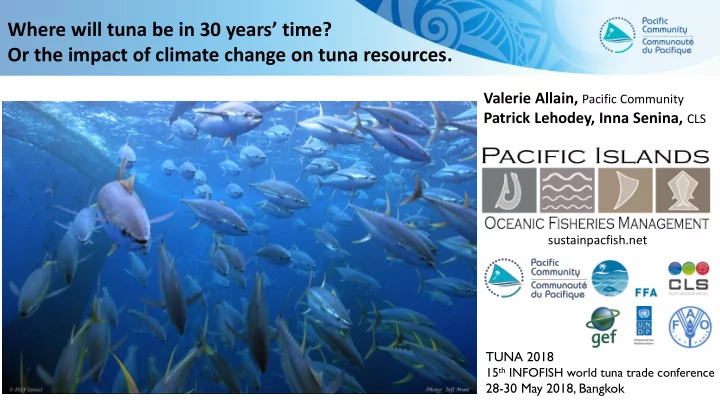

Where will tuna be in 30 years’ time? Or the impact of climate change on tuna resources. Valerie Allain, Pacific Community Patrick Lehodey, Inna Senina, CLS sustainpacfish.net TUNA 2018 15 th INFOFISH world tuna trade conference 28-30 May 2018, Bangkok
OUTLINE 1. Importance of tuna in the WCPO 2. Climate impact 3. Model and climate scenario used 4. Impact on tuna 5. Impact on Pacific Islands References: Lehodey, P., Senina, I., Calmettes, B., Dessert, M., Nicol, S., Hampton, J., Smith, N., et al. 2017. Modelling the impact of climate change including ocean acidification on Pacific yellowfin tuna. 13th Meeting of the Scientific Committee of the Western and Central Pacific Fisheries Commission, WCPFC-SC13, Rarotonga, Cook Islands, 9-17 August 2017, WCPFC-SC13-2017/EB-WP-01: 1 – 26. https://www.wcpfc.int/system/files/EB-WP-01%20SEAPODYM.pdf Senina, I., Lehodey, P., Calmettes, B., Nicol, S., Caillot, S., Hampton, J., and Williams, P. G. 2016. Predicting skipjack tuna dynamics and effects of climate change using SEAPODYM with fishing and tagging data. 12th Meeting of the Scientific Committee of the Western and Central Pacific Fisheries Commission, WCPFC-SC12, Bali, Indonesia, 3-11 August 2016, WCPFC-SC12-2016/EB WP-01: 1 – 71. https://www.wcpfc.int/system/files/EB-WP-01%20SEAPODYM%20SKJ%20Fixed.pdf
1. Importance of tuna in the Western and Central Pacific Ocean 2.7 million tonnes of tuna 2016 56% of the global tuna catch 5.3 billion USD
1. Importance of tuna in the Western and Central Pacific Ocean Status of stocks
2. Climate impact La Niña Transition El Niño Purse seine effort Water >28.5°C
2. Climate impact Impact on the ocean
2. Climate impact Impact on the fish and its optimal habitat: temperature and oxygen prey and predators surface 100 m Warm High oxygen Skipjack Yellowfin 500 m Low oxygen Albacore Bigeye Cold depth
3. Model and climate scenario used SEAPODYM Model fisheries Tuna population (larvae, immature, adult) Resolution 1° x month 6 forage groups Environmental constraints: temperature, currents, Primary oxygen, euphotic depth, production ocean acidification
3. Model and climate scenario used IPCC scenarios RCP 8.5 - Business as usual, CO2 emissions keep increasing until 2100 RCP 6.0 – decline of CO2 emissions after 2080 RCP 4.5 – decline of CO2 emissions after 2040 RCP 2.6 – decline of CO2 emissions after 2020
4. Impact on tuna Hu et al. 2015
4. Impact on tuna Skipjack Yellowfin 2005 2050 2100
4. Impact on tuna Bigeye Albacore 2005 2050 2100
4. Impact on tuna
5. Impact on Pacific Islands Rep. of Marshall Islands 12% Fed. States of Micronesia Kiribati 40% 80% Proportion of tuna revenue in government revenue Papua New Guinea 4% Solomon Islands Tuvalu 9% 52%
5. Impact on Pacific Islands Projected % changes in biomass in Pacific Island countries EEZs
CONCLUSION • Models predict a decrease in tropical tuna biomasses in the Pacific a shift of the biomasses of tropical tuna towards the east, and towards the south for albacore a strong impact at the national level • The main driver of changes is the warming temperature, ocean acidification is predicted to have a limited impact • Improving models to improve the accuracy and confidence of the forecast for better management and adaptation • Better observation of fisheries • Better observation and understanding of the pelagic ecosystem • Models can be used to project the impact of fishing that remains the major external driver of the tuna population dynamics. Different fishing scenarios can be tested.
Recommend
More recommend